Unlocking the diverse experiences of Yunnan tourism

A view of the Meili snow mountain in northwest Yunnan's Diqing prefecture
From indoor ski resorts on the Tropic of Cancer to lively night market streets and from the booming sales of cultural and creative products in museums to the rich aroma of coffee wafting through coffee manors, Yunnan is transforming its tourism landscape through diversity and innovation.
The ice and snow economy has sparked a trend for “skiing under the warm sun” in the south. Distinctive urban neighborhood developments and a thriving night economy are revitalizing city life. Intangible cultural heritage products breathe life into historical relics, making culture both accessible and engaging. Homestays and manors reflect the warmth of the “Yunnan lifestyle,” while border villages and stockaded communities draw visitors in with their pastoral allure.
Through cross-border integrations like “ice and snow +,” “culture +,” and “homestay +,” Yunnan not only taps into its consumption potential but also showcases a vibrant model of high-quality cultural tourism development characterized by unique experiences.
Igniting the thrill of ice and snow activities
Text by Chen Chen
Following the successful conclusion of the 9th Asian Winter Games in Harbin, the City of Ice and Snow, tourists in Yunnan are now enjoying the snow-capped mountains aboard the “Lijiang Snow Mountain Sightseeing Train.” At the Shangri-La Ski Resort, skiers are gliding down the slopes as the snow begins to clear. Meanwhile, Kunming’s indoor ski resort has made skiing a spontaneous and accessible sport for all.
Situated near the Tropic of Cancer, Yunnan Province enjoys a mild climate, with relatively little snowfall. However, this has not deterred the people of Yunnan from embracing their passion for ice and snow. The recent hosting of international events such as the 2022 Beijing Winter Olympics and the 9th Asian Winter Games has fueled a vibrant enthusiasm for winter sports among the residents of Yunnan.
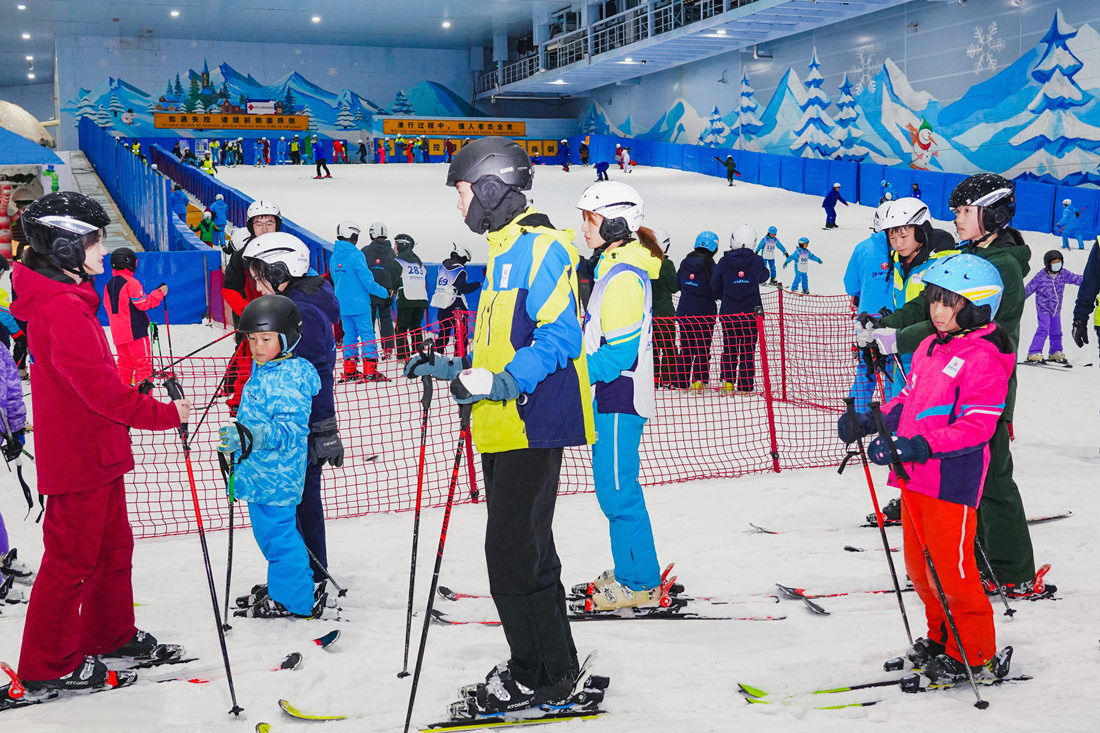
Kunming Bonski, an all-season indoor snow field, is bustling with skiing fans.
Kunming Bonski, an all-season indoor snow field, is bustling with activity as parent-child groups and tour groups enjoy skiing and other winter activities in various areas. According to Song Guangxu, the general manager of Kunming Bonski, there are significant differences in the development of the ice and snow industry between northern and southern regions. In the north, long, cold winters enable the establishment of outdoor ski resorts that depend on natural snowfall and low temperatures. In contrast, the warmer climate of the south primarily supports indoor ski resorts. Market positioning also differs, with the north attracting tourists and focusing on ice and snow tourism as well as professional experiences, while the south caters to local residents and emphasizes urban leisure sports.
The people of Yunnan are not the only ones eager to enjoy the snow; snow enthusiasts from Southeast Asia are also drawn to winter activities. In 2024, Diqing Zang Autonomous Prefecture welcomed over 200,000 tourists from Southeast Asian countries, marking a remarkable year-on-year increase of 243%. From November of last year through the Spring Festival this year, the number of overseas visitors to the Kunming Jiaozishan Scenic Area—the “seasonal snow mountain closest to Southeast Asia”—grew nearly threefold compared to the previous year, with tourists from Thailand and Vietnam comprising the largest groups.
Since November of last year, Huang Xue, the brand manager of the Lien Minh Van Nam Group Tour, has been actively organizing outbound tour groups from Vietnam to Yunnan. The tours to Jiaozishan Snow Mountain and Yulong Snow Mountain on Fridays have become some of her bestsellers. To date, the company has sold over 10,000 Yunnan snow mountain tour packages. Huang Xue has also had the pleasure of witnessing a memorable moment when a Vietnamese tourist proposed marriage beneath a breathtaking snow-capped mountain of Yunnan.
“When people think of ice and snow sports, they often envision extreme cold. However, in Yunnan, the combination of low latitude and high altitude creates stunning snow-capped mountains that thrive under the warm sun. Here, outdoor ice and snow activities are quite comfortable, allowing people to enjoy the thrill of winter sports while also immersing themselves in Yunnan’s rich ethnic customs.” Nguyễn Thu Phương, a Vietnamese tourist who recently returned from Lijiang, has already begun planning her next trip to Yunnan at the end of this year for a folk-custom-themed snow mountain tour.

Nguyễn Thu Phương, a Vietnamese tourist, has leisure at a Lijiang snow-capped mountain.
Once, traveling north or even abroad to enjoy the snow was a dream for many. Today, the emergence of ski resorts closer to home has made snow activities more accessible and commonplace, shifting them away from being considered luxury experiences. In this new landscape, innovative tourism models such as “ice and snow + tourism” and “ice and snow + culture” are enriching the experiences available to visitors.
In January of this year, the Shangri-La Ski Resort officially opened its doors to guests, offering fully operational beginner and intermediate ski runs. According to General Manager He Chenxi of Diqing Shangri-La Skiing Tourism Development Co., Ltd., in addition to skiing, the area features a variety of entertainment options, including snowmobiling. By creatively incorporating ice and snow elements with the region’s natural landscapes and ethnic traditions, Diqing’s themed tour—which includes “enjoying the golden mountains bathed in winter sun, skiing in the snow, and birdwatching”—has become extremely popular.
The appeal of “ice and snow +” continues to grow. Huang Xiaotao, the marketing director of Yunnan Jiaozishan Scenic Area, noted that ski equipment rental shops in Jiaozi Snow Mountain are thriving, with ski training institutions emerging to meet increased demand. Local farmers’ restaurants have introduced a range of cultural and entertainment activities, including rice noodle soup sets after a day on the slopes, bonfire parties, and ethnic song and dance performances. These secondary consumption opportunities, fueled by ice and snow tourism, have experienced significant growth, contributing to the continued expansion of the ice and snow economy in Yunnan.
Unique streets teeming with surprises
Text by Zhu Hai
In recent years, the unique cultural streets across Yunnan have become increasingly popular destinations for strolling, shopping, and dining. Many cities are actively working to develop these distinctive blocks, and the emerging trending projects are offering a wealth of enriching experiences for tourists.
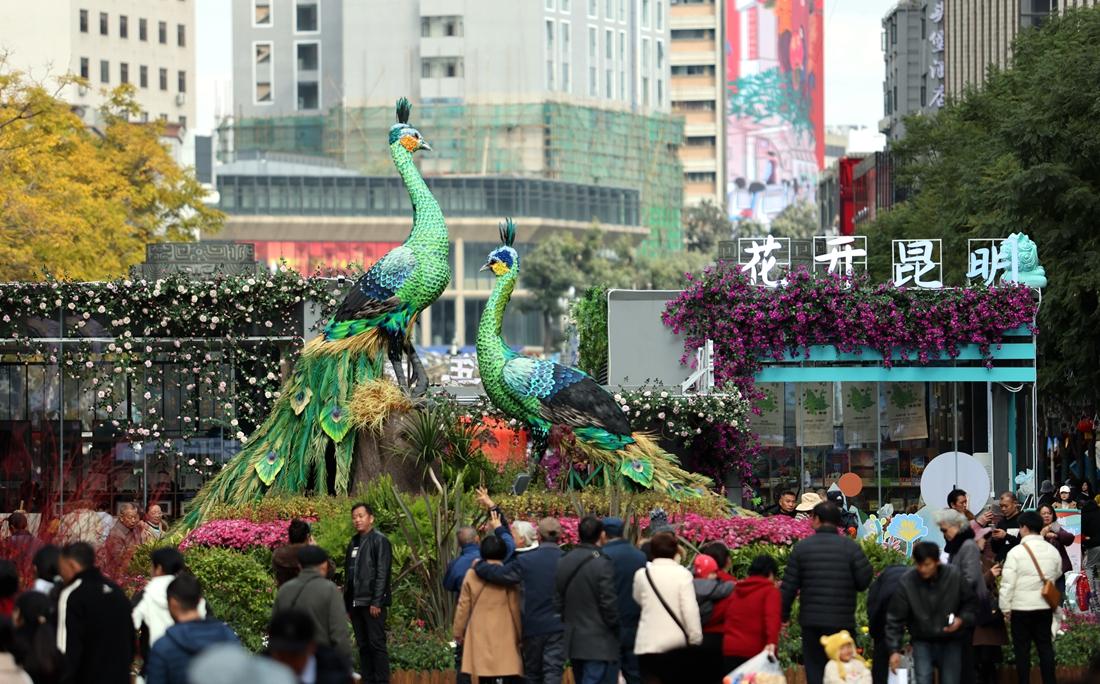
Visitors immerse themselves in Kunming’s vibrant cultural and artistic atmosphere.
The Nanping Pedestrian Area in Kunming includes Nanping Street, Zhengyi Road, Kunming Old Street, and Nanqiang Street. Historically, it has been a lively financial, commercial, and entertainment center, functioning as the city’s reception hall. In recent years, the area has skillfully combined tradition with modernity and culture with fashion, creating a vibrant destination that highlights cultural and artistic elements, trendy fashion, aesthetic living, local customs, and a variety of leisure and entertainment options.
“The street markets evoke a strong sense of nostalgia, reminiscent of childhood experiences. They offer a diverse array of goods and provide opportunities to learn traditional crafts, such as paper-cutting window flowers.” On the 15th day of the first lunar month, tourists, flocked to three main markets—the Jingxing Flower and Bird Fair in Kunming Old Street, the Spring City New Year Taste Fair on Zhengyi Road, and the Snake Year Grand Fair on Sanshi Street—to fully immerse themselves in the festive atmosphere of the Spring Festival. These new consumer experiences have injected fresh vitality into the festival economy. According to statistics, during the Spring Festival holiday, the total visitor count at Nanping Pedestrian Area surpassed 3.5 million, while the business turnover reached 280 million yuan.
In Kunming, a travel style centered around citywalks is gaining popularity, with more people opting for it over the “travel special forces” approach. Yang Fan, the owner of a coffee shop on Xunjin Street—often compared to Shanghai’s Wukang Road—pointed out that, thanks to government protection and revitalization efforts, Xunjin Street has evolved into a trendy tourist destination. The seamless blend of historic buildings, coffee shops, creative murals, and distinctive bookstores has attracted many young visitors who come to enjoy leisurely strolls and immerse themselves in Kunming’s vibrant cultural and artistic atmosphere.
As the stars begin to twinkle and the night deepens, each unique city in Yunnan offers an enchanting experience. The night economy thrives with vibrant energy, becoming a new driving force for consumption growth.
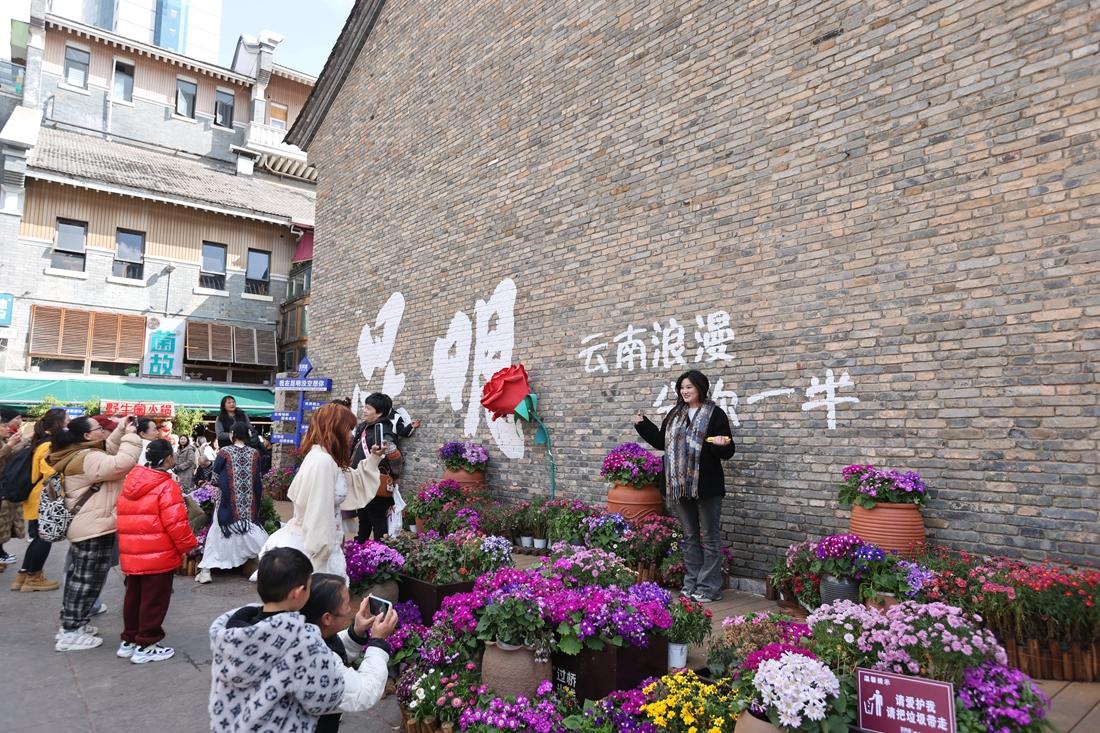
Visitors immerse themselves in Kunming’s vibrant cultural and artistic atmosphere.
As one of the largest and most vibrant night markets in Southeast Asia, the Starlight Night Market in the Gaozhuang Xishuangjing Scenic Area of Jinghong City, Xishuangbanna Dai Autonomous Prefecture, has transformed from a modest street night market into a bustling hub of activity. It features a business model that combines “street stalls + waterfront,” offering a diverse array of goods and experiences. This market has developed into a cultural and creative space that seamlessly integrates industry, city, people, and culture.
By providing comprehensive services such as tourism shopping, immersive folk experiences, and unique dining options, the market ensures safety and convenience for visitors through measures like separating pedestrian and vehicle traffic, as well as establishing parking lots, tourist service centers, and merchant management centers. “With approximately 3,000 stalls and over 300 shops in the pedestrian area, the market creates more than 6,000 entrepreneurial and employment opportunities, attracting around 10 million visitors each year. The Starlight Night Market has achieved significant scale and unique character,” said an official from the Culture and Tourism Bureau of Xishuangbanna Dai Autonomous Prefecture.
Today, Yunnan is rapidly advancing the development of its night economy, invigorating various consumption formats such as night shopping, dining, entertainment, tours, fitness, and performances. The province is also cultivating 20 influential provincial-level night economy hubs. In Yunnan, the nights are becoming increasingly vibrant and beautiful!
Museum offers a lot to explore
Text by Chang Yuan
Upon entering the Yunnan Provincial Museum, visitors can immerse themselves in the ancient Dian civilization through a diverse collection of cultural relics. In the cultural and creative store, they have the unique opportunity to polish a bronze mirror, create a cloisonné enamel painting, and enjoy a “grenade ice cream” inspired by the revolutionary artifact. In recent years, this national first-class museum has adopted an innovative approach that integrates “exhibitions + activities + intangible cultural heritage + cultural and creative products,” bringing cultural relics to life and fostering vibrant cultural consumption.
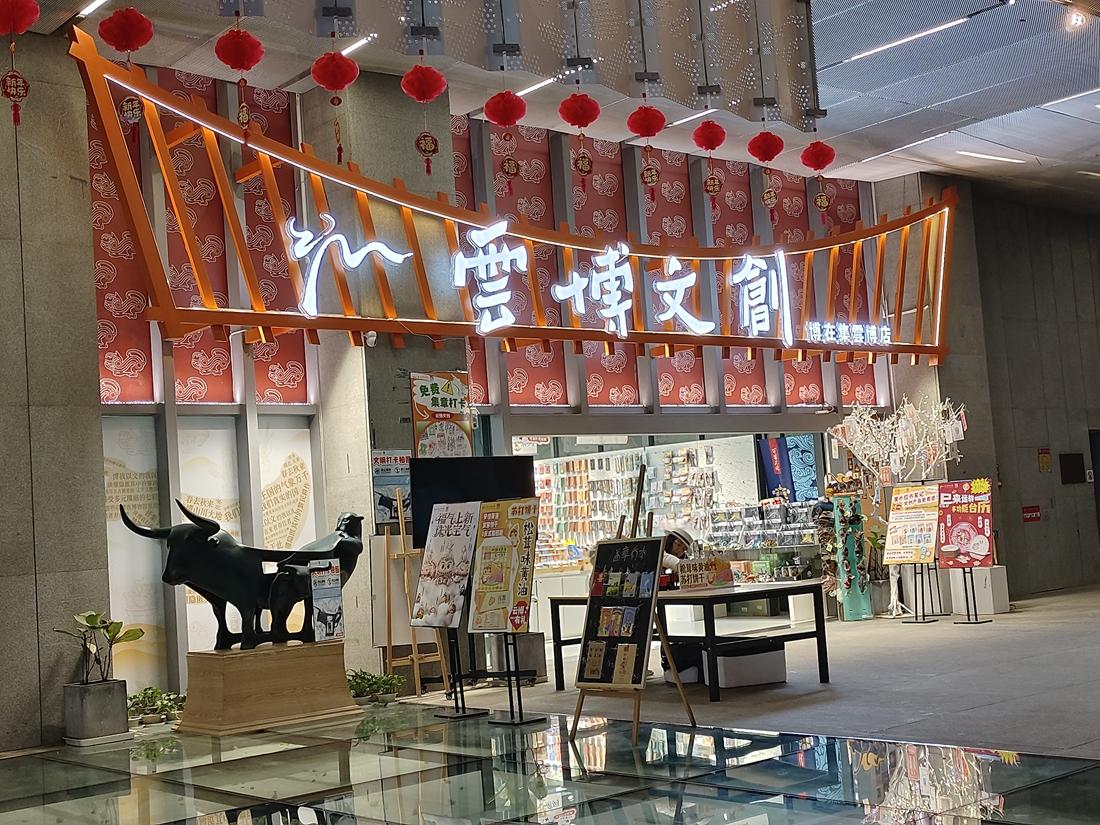
Creative cultural products are displayed at Yunnan Provincial Museum.
During the Spring Festival of the Year of the Snake, certain products in the cultural and creative store of the Yunnan Provincial Museum sold out. This trend reflects the museum’s transformation from a traditional cultural institution into a dynamic space, as well as the evolution of cultural consumption from passive observation to active engagement.
In 2016, the Yunnan Provincial Museum was designated as one of the 92 cultural and creative pilot units in the country, marking the beginning of a rapid development phase for original cultural products. Today, the museum offers a diverse range of over 1,000 cultural and creative products for sale, with more than 100 new items introduced each year. These products span various life scenarios, including jewelry, home furnishings, stationery, and food.
“Cultural and creative products are not mere replicas of cultural relics; they are a modern retelling of history,” said Cai Xue, the director of the Cultural and Creative Development Center at the Yunnan Provincial Museum. For instance, the fierce tiger depicted on the museum’s prized “Bronze Table in the Shape of One Tiger and Two Oxen” has been reimagined as the charming and quirky tiger from the “I’m Not a Fat Tiger” comic series, delighting consumers. Additionally, the “Gilt Silver Garuda Inlaid with Pearls” from the Dali Kingdom during the Song Dynasty (906-1276) has been transformed into a highly sought-after 18K gold necklace. These products not only incorporate elements of cultural relics but also make history and culture more accessible through IP development, practicality, and interactivity.
The integration of intangible cultural heritage techniques with cultural relics is a key aspect of the cultural and creative products at the Yunnan Provincial Museum. In the DIY area on the second floor, visitors can engage in activities such as creating cloisonné enamel paintings, crafting tin handicrafts, and polishing bronze mirrors. For instance, in the bronze mirror polishing experience, participants can reconnect with ancient rituals by using bronze mirrors to “adjust their clothes and hats,” while also expressing their modern aspirations for academic success and good health. “Consumers are not just purchasing products; they are seeking a sense of participation and cultural identity,” said Cai Xue. The cultural and creative experiences offered at the Yunnan Provincial Museum are accessible to all, with material packages available at an affordable price. As the activities continue to be refined, the participation rates among consumers are steadily increasing.
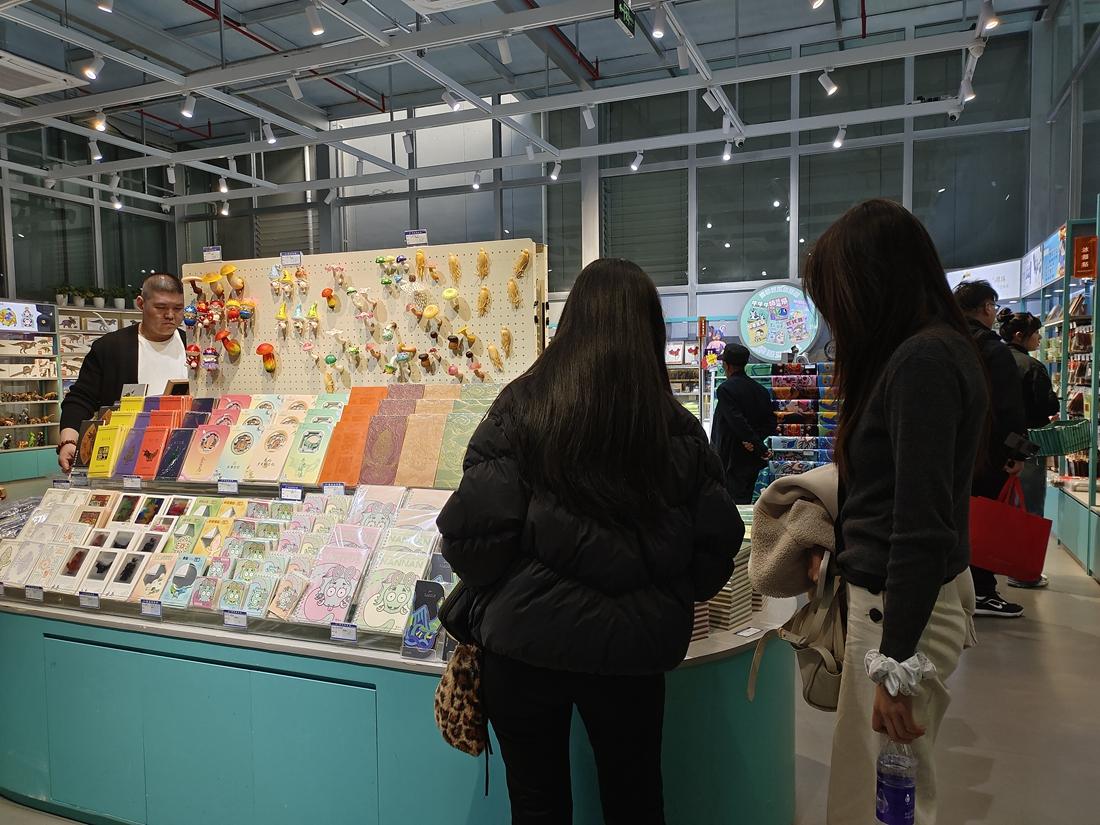
Visitors show interest in the cultural products at Yunnan Provincial Museum.
Currently, cost-effective and lightweight cultural and creative products have become the dominant choice among consumers. Popular items include tile cat fridge magnets, cultural relic keychains, and seal notebooks. However, consumers do not simply seek the lowest prices; they also prioritize texture and stories, which hold significant value in their purchasing decisions.
“Consumers are willing to pay for emotional value,” analyzed Cai Xue. The younger generation places greater importance on the cultural narratives behind products. “Cultural and creative products are not merely commodities; they should embody the value of cultural relics and historical stories, presented in a way that resonates with the public. It’s less about creating a successful cultural and creative product and more about collaboratively sharing the story of a cultural relic effectively.”
Transitioning from being a “guardian of cultural relics” to a “cultural innovator,” the Yunnan Provincial Museum exemplifies a significant trend: when traditional culture is revitalized through creativity and technology, it not only intertwines history with the present but also unlocks consumption potential. As Cai Xue noted, “Museum cultural and creative products serve as a rainbow bridge connecting the past and the future, bridging the gap between cultural relics and visitors.” This bridge is transforming the niche appeal of the museum into a new necessity within the mass cultural market, crafting a compelling narrative of cultural consumption.
Home away from home: Engaging activities await
Text by Zhang Min
When tourists seek more than just a photo opportunity, when the homestay owner offers a glass of homemade plum wine instead of just a room key, and when conversations by the fire become more memorable than guided tours of scenic spots—a transformation is quietly unfolding in Yunnan. It is no longer merely a “tourist destination.” Rather, with the warmth of homestays, local vibrancy, and innovative experiences, it invites tourists to pack the “Yunnan lifestyle” into their suitcases.
Nestled deep within the ancient tea forests of Jingmai Mountain in Pu’er City, the fireplace at the Vipaxana Abailai Homestay is always alight. Yang Jianwei, the manager, shares the cultural allure of this soulful tea mountain with visitors through a variety of experiential activities, allowing them to enjoy unique Jingmai nights. In the early morning, guests can accompany a Bulang elder to pick tea; in the afternoon, they can knead tea cakes using traditional methods while connecting with the spiritual energy of the mountains and fields during yoga meditation. As night falls, everyone gathers around the fireplace to roast glutinous rice cakes over the open flames.
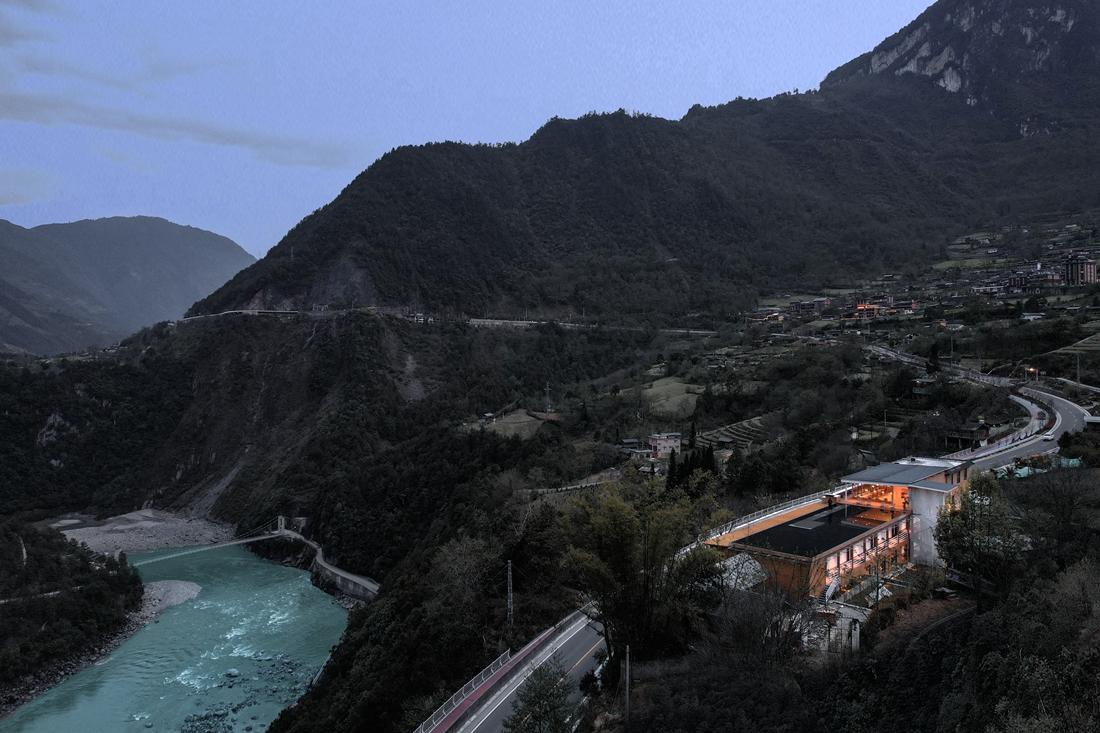
The Yunye·Jianjiang Homestay is nestled within the Nujiang Grand Canyon, northwest Yunnan.
The Vipaxana Abailai Homestay has maintained an impressive occupancy rate of over 90% for 70 consecutive days. Tourists from as far away as Norway and Singapore have already booked guest rooms and tea culture experiences for November this year. “They’re not here just to see Yunnan, but to experience the Yunnan lifestyle,” Yang Jianwei remarked with a smile. Today, activities such as tea picking, mushroom foraging, and hiking have been seamlessly integrated into the daily life of the homestay. Even the volunteers have taken on the role of “part-time tea farmers,” making the homestay a bridge that connects local culture with the aesthetics of everyday life.
With its cream-colored decor, Dai ethnic pattern cushions, and a courtyard always filled with the aroma of freshly brewed coffee, the Jianhe Homestay in the Dai Ancient Town of Mangshi, located in the Dehong Dai and Jingpo Autonomous Prefecture, radiates warmth. Zhang Ailing, the manager, reveals her secrets in the finer details: “We customize travel itineraries for guests who need them and provide high-quality accommodations and dining services. The laughter and excitement from barbecues and games in the courtyard have transformed strangers from all over the country into friends. This year, we also organized a long-street banquet for guests staying on Chinese New Year’s Eve, allowing them to celebrate with a festive dinner.”
This family-oriented service has allowed the Jianhe Homestay to achieve an impressive annual occupancy rate of 80%. Guests’ brief visits have often transformed into lasting emotional connections. “Thanks to running the homestay, I’ve made many homestay friends. They come here to unwind for a few days now and then. We explore the ancient town together, share conversations, soak up the sun, and even exchange local specialties,” Zhang Ailing said.
The enhancement of homestays involves not only upgrading the physical facilities but also embracing multi-dimensional scene innovations centered around the concept of “homestay +.”
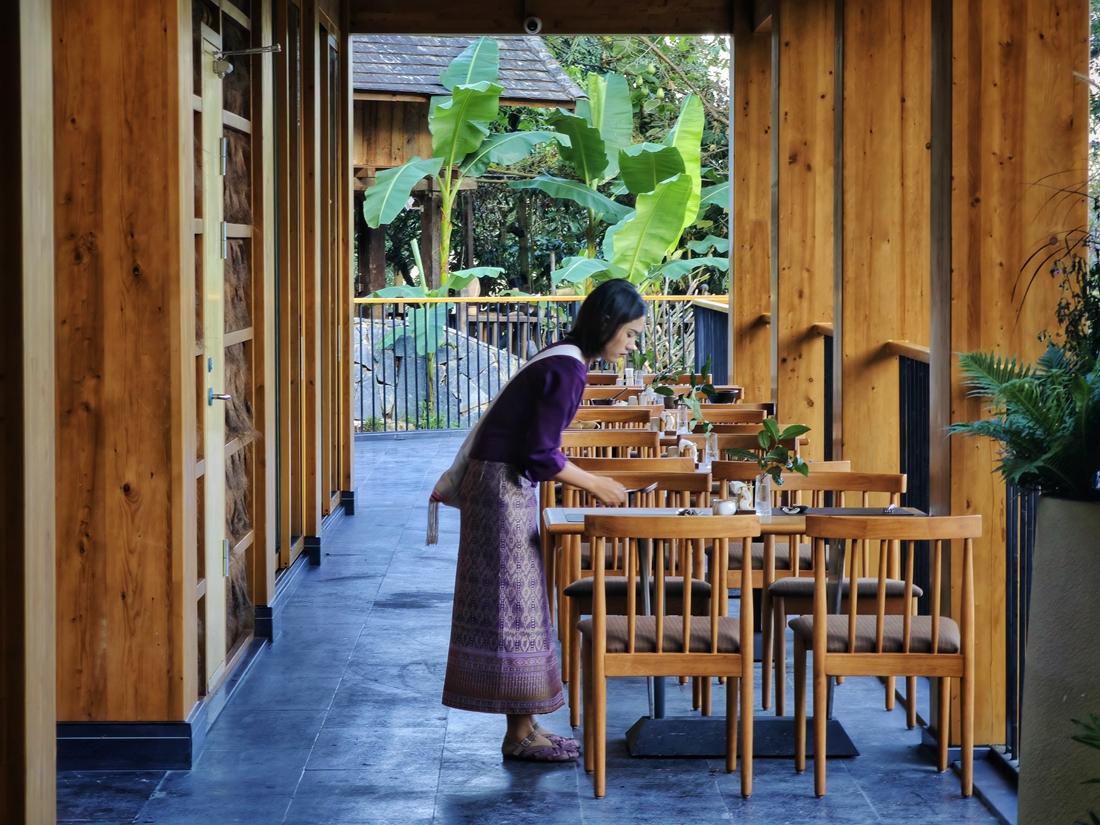
An interior view of the Vipaxana Abailai Homestay in the ancient tea forests of Jingmai Mountain in Pu’er City.
Bingzhongluo Town, situated in the northernmost part of Gongshan Dulong and Nu Autonomous County within the Nujiang Lisu Autonomous Prefecture, serves as a significant waypoint on the Greater Western Yunnan Tourism Ring Route and is a vital part of the core area of the “Three Parallel Rivers” World Natural Heritage site. The Yunye·Jianjiang Homestay, nestled within the Nujiang Grand Canyon, offers an exceptional vantage point for viewing the sea of clouds. To attract visitors, the homestay features a stunning infinity pool that has become a popular photography spot. Manager He Xiaohu shared, “We see all kinds of photos taken here—proposal photos, family portraits, and couple shots. The homestay is more than just a place to stay; it embodies the memories of important moments in people’s lives.”
The Yunye Jianjiang Homestay is actively exploring a new business model that combines “homestay + outdoor activities + photography.” By leveraging the abundant outdoor resources in Bingzhongluo, it integrates travel photography with various outdoor experiences while also training talented local youth to become photographers, offering tourists more diverse options. This innovative approach not only provides fresh experiences for visitors but also establishes a foundation for Bingzhongluo’s ambition to become a premier outdoor destination.
Currently, Yunnan has explored innovative integrated business models under the “homestay +” concept, such as combining homestays with sports, travel photography, camping, and intangible cultural heritage. These offerings not only enrich the travel experiences for visitors but also create countless beautiful moments. Together, these moments encapsulate the essence of Yunnan’s sojourn economy: instead of focusing on temporary impressions, it celebrates the beauty of everyday life that invites people to “stay.” The flickering flames in the fireplace, the swaying tube skirts hanging on the clothesline in a quaint courtyard, and the smiling faces reflected in the infinity pool all serve as vivid reminders of Yunnan’s many-splendored life.
Discovering new encounters in gardens
Text by Zhu Hai
These days mark the coffee harvesting season, and Luo Bin’s family from Jilin Province enjoyed a visit to the surrounded by the rich aroma of freshly roasted coffee. They relished the unique blend of coffee culture and tourism the manor offered. “This is our first trip to Pu’er. We discovered this coffee manor on social media, and experiencing it in person has truly made the journey worthwhile.”
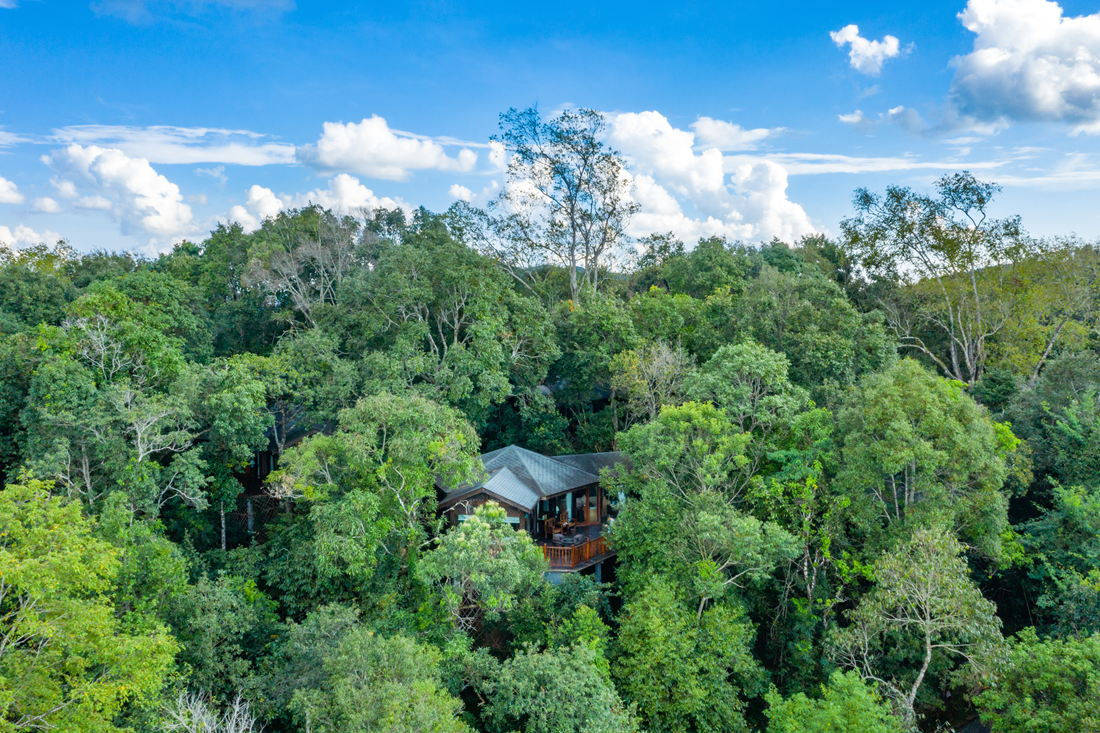
A forest coffee house in Simao District, south Yunnan's Pu’er city
Entering the coffee forest, they personally picked bright red coffee cherries and visited the coffee production line to learn about the journey from seed to cup. They enjoyed tastings of pure Pu’er coffee and Simao cuisine at the manor’s dining bar. The experience also included displays and hands-on activities featuring intangible cultural heritage, such as out-of-print woodcarving, traditional pottery making, and Wa ethnic brocade weaving. Like many tourists from various places, Luo Bin’s family spent several days at the themed boutique homestay that opened in the manor last year. “The homestay is often fully booked, and our hand-brewed coffee is extremely popular,” said Hua Runmei, the manager of Dakaihe Coffee Manor, with a smile.
The popularity of Dakaihe Coffee Manor serves as a prime example of the success of various coffee estates in Pu’er, which have effectively leveraged their resource advantages. By emphasizing their unique attributes, these estates have evolved into comprehensive destinations that provide a blend of cultivation, processing, tasting, and tourism experiences. A representative from the Agriculture and Rural Affairs Bureau of Pu’er City noted, “With the emergence of new consumption trends, more coffee enthusiasts are eager to visit and experience the origins of their coffee. Each Pu’er coffee estate has its own distinct characteristics, offering unique experiences that draw visitors from far and wide to engage with the local coffee culture.” In the past six months, the high-quality coffee estates in the Simao District of Pu’er have seen significant growth, with twelve estates—including Beigui, Yeyatang, and Xiaoaozi—undergoing substantial enhancements to provide fresh and exciting experiences for tourists.
The cluster of boutique coffee manors is gradually taking shape, propelling the coffee industry and cultural tourism consumption in Pu’er into the “fast lane.” During the Spring Festival holiday, these coffee manors attracted large crowds. Six notable manors, including Aini, Xiaoaozi, and Tianyuzhuang, welcomed over 35,000 visitors and generated an income of more than 2 million yuan.
Each cup of Pu’er coffee reflects the cultural richness of its origin, while each popular science class ignites curiosity about exploring the natural world. During the winter vacation, the Yunnan Zoo in Kunming saw a surge in science research activities, with over a thousand families engaging in courses aimed at understanding and protecting wildlife.
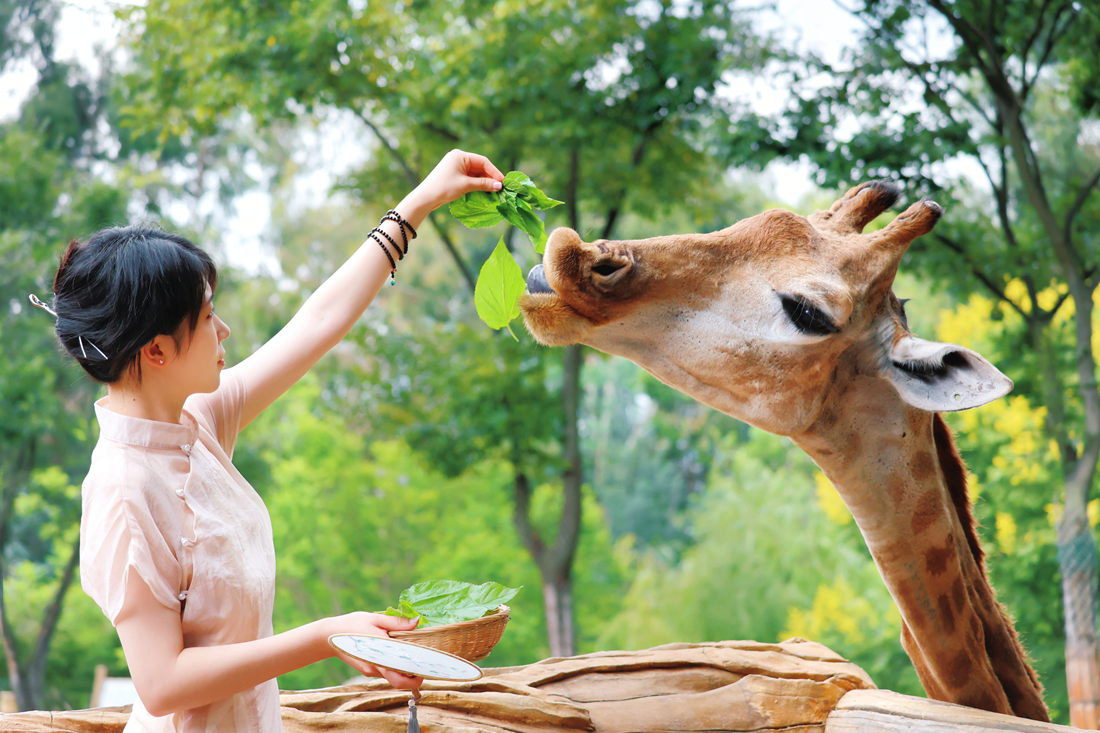
A tourist feeds a giraffe at the Yunnan Wildlife Park.
The Yunnan Zoo stands as a national leader in popular science education. In 2017, it established a dedicated department for this purpose and launched the Natural Classroom project. Aimed primarily at minors, this initiative highlights Yunnan’s rich local culture as a “Kingdom of Animals and Plants” while leveraging the zoo’s diverse wildlife resources. Through the project, the zoo offers a range of activities and social practices, including scientific research, career exploration, and labor education, all situated within the park environment.
“In recent years, we have come to better understand that the continuous enhancement of models and qualities in popular science tourism products is a key strategy to stimulate cultural tourism consumption,” said the head of Yunnan Zoo. The park’s outreach in public popular science exceeds 900,000 visitors annually, playing a significant role in encouraging the public to protect wildlife and the ecological environment.
Nature has bestowed Yunnan with abundant resources, including a diverse array of animals and plants, which create favorable conditions for developing new consumption models. Today, various locations in Yunnan, such as botanical gardens, zoos, and agricultural estates, are effectively utilizing these natural resources. By offering innovative experiential business models, they provide tourists with engaging and rewarding experiences, showcasing the rich and varied consumption potential within agriculture, culture, and tourism. This approach not only enhances the quality of consumption experiences but also drives their evolution.
Rural areas promise enhanced happiness
Text by Guo Yao
Instead of rushing through their travels, people are now taking the time to fully enjoy the journey. An increasing number of individuals are embracing rural tourism, choosing to immerse themselves in local customs and cultures. Yunnan Province, which shares borders with Myanmar, Laos, and Vietnam, features a border of over 4,000 kilometers. This extensive border connects 28 open ports, 25 border counties (or cities), and 374 charming border villages. Visiting these villages to experience their diverse cultures has emerged as a new trend in travel.
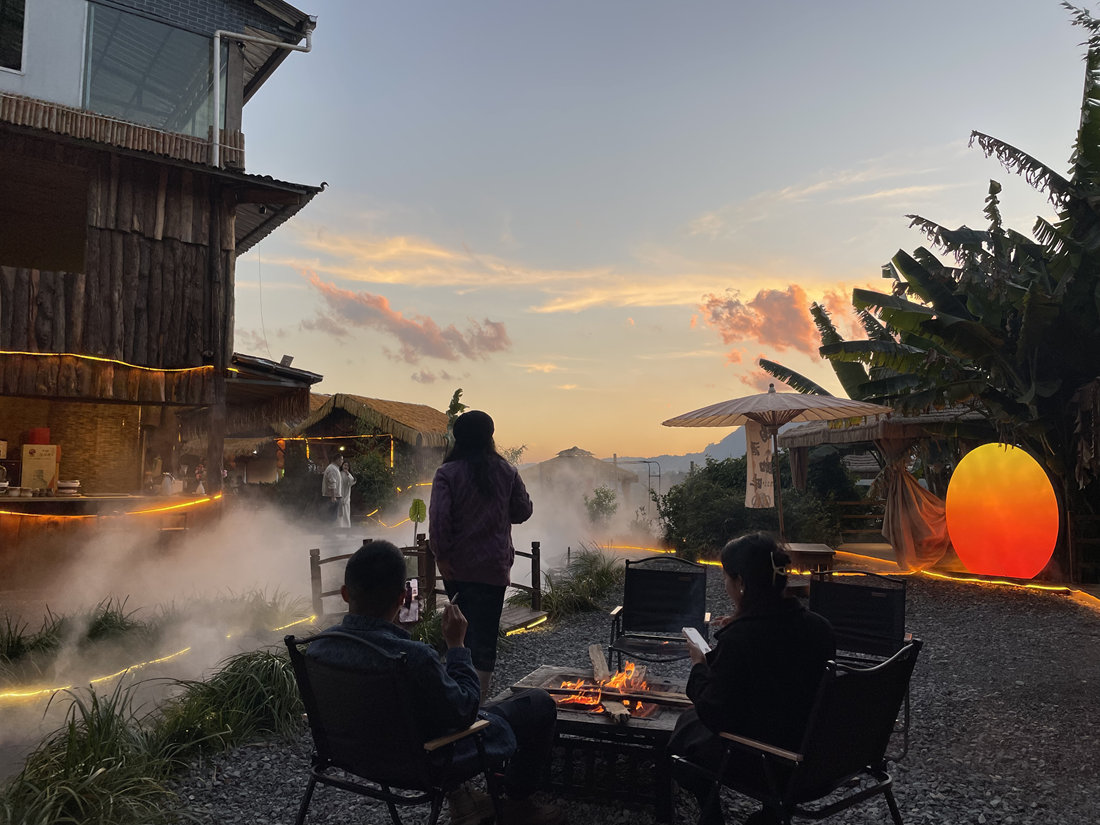
Tourists dip into folk customs in southwest Yunnan's Lincang city.
Ms. Zhu from Shanghai, after spending some time in Heshun Ancient Town in Tengchong City and Sanman Village in Jinghong City, remarked, “The stunning landscapes, the clear starry skies, the tranquil villages, and the fresh local ingredients are treasures not found in the city. I feel truly at ease here. Additionally, the affordable cost of living allows me to immerse myself in local traditions and different cultures.”
Each village, with its unique scenery, attracts visitors from all directions. In recent years, the border villages in Yunnan have incorporated various elements into their tourism offerings, including stunning border views, red culture, rich ethnic traditions, health and leisure activities, and farming experiences. This has resulted in diverse and immersive local experiences for tourists.
Dehong Dai and Jingpo Autonomous Prefecture is focused on developing three primary brands: ecological sustainability, Dehong cuisine, and border tourism. Long’an Village, located along the China-Myanmar border in Longba Town, Longchuan County, is nurturing unique industries such as sericulture, tangerine farming, rice and lotus field fishing, and under-forest breeding, all through a “scenic area + farmhouse + sightseeing and shopping” model. The “One Village Straddling Two Countries” scenic area in Ruili City beautifully illustrates the fusion of Chinese and Myanmar cultures. Significant landmarks, such as the “One Well Shared Between Two Countries,” “One Swing Spanning Two Countries,” and the “China-Myanmar Jade Border,” have become popular attractions, inviting tourists to capture unforgettable moments through photography. International events like the China-Myanmar Border Residents Gala and the China-Myanmar Transnational Marathon have attracted numerous visitors, fostering cultural and sporting exchanges and allowing them to experience the deep-seated “Paukphaw” friendship.
Lincang City is dedicated to showcasing the “beauty of the border” and is actively working to create a vibrant and picturesque border area. The incorporated Cishuyakou Village, located in Nansan Town, Zhenkang County, is just 50 meters from the China-Myanmar border and is affectionately referred to as the “First Sentinel of the Hundred-Li Border.” This area boasts a thoughtfully arranged collection of iconic attractions, such as the red border plank road, a city-viewing platform, a border defense museum, and a mountainside hotel. Visitors can enjoy breathtaking views along the 27-turn mountain road, hike the border patrol plank road, listen to inspiring stories of border defense, and take in the distinctive “One City Riding Astride Two Countries” border landscape.
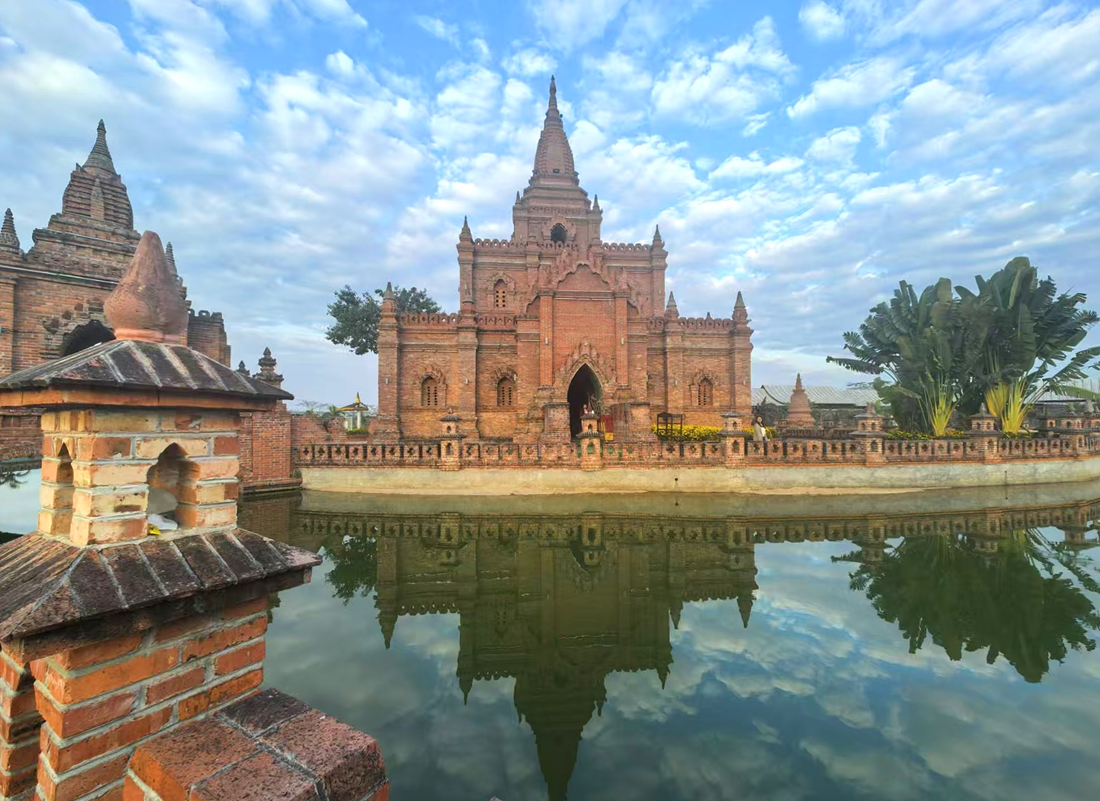
A Ruili village lies on the China-Myanmar border section in west Yunnan.
Honghe Hani and Yi Autonomous Prefecture is fully leveraging the 240-hour visa-free transit policy to boost cross-border tourism. The Batiaoban Villagers’ Group, part of Chengjiao Village in Hekou Town, is the last Chinese village before the cross-border freight trains on the China-Vietnam meter-gauge railway depart the country. The railway runs through the village, symbolizing the fusion of history and modernity. The village features neatly arranged, bright yellow French-style buildings that showcase a revitalized countryside. “There are scenic plank roads, infinity pools, barbecue campsites... all offering fantastic spots for tourists to relax and have fun,” said Xiao Xue, a Vietnamese live-streamer who recently passed through Hekou Port. She enthusiastically promoted Batiaoban Village on social media, inviting Vietnamese netizens to visit and discover the surprises it has to offer.
Many distinctive villages in Menghai County, Xishuangbanna Dai Autonomous Prefecture have successfully implemented the “one village, one product” model. Longli Village in Daluo Town has diversified its offerings, developing red-border tourism, fruit and vegetable picking, homestays, catering services, and “dew” markets. Manya Village integrates intangible cultural heritage with rural tourism, while Manzhang Village is known for its border trade and ecological tourism, attracting a large number of visitors eager to experience these unique offerings.
Fifteen villages in the Wenshan Zhuang and Miao Autonomous Prefecture each possess their own unique charm. Xianrendong Village and Puzhehei Village in Qiubei County boast nearly 600 distinctive homestays. A variety of leisure vacation activities, including ecological sightseeing, low-altitude flights, and performances of intangible cultural heritage, offer a rich and vibrant experience, allowing tourists to fully embrace the serene pastoral life amidst the mountains and waters. In villages like Masa Zhuang Cultural Tourism Village, Lake Yi Cultural Tourism Village, and Anuo Bai Cultural Tourism Village, visitors can wander through the picturesque farmlands, savor authentic rural cuisine, and experience the vibrant farming way of life.
Rural areas boast stunning landscapes in each of the four seasons, with every border region showcasing its unique charm. The tourism in these border villages, rooted in the fusion of culture and nature, ecological sustainability, and strong community ties, offers visitors a tranquil escape in the picturesque countryside. This experience allows the concept of “poetry and distant lands” to flourish in these happy border villages.
Translated by YNTA